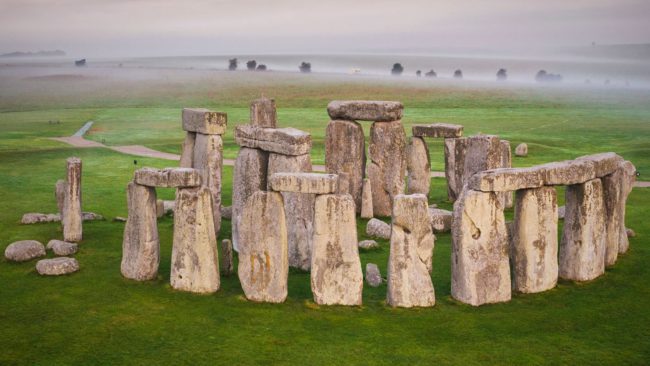
Dotted across the landscape in Ireland, the UK, and many other parts of Europe and beyond are huge standing stones. The most dramatic are well-known. (Stonehenge as pictured above).
We don’t simply have one or two examples, there are at least 50,000 documented examples.
When were these standing stones erected?
Dating a standing stone can be done by dating bits of pottery found underneath. This clearly identifies them as middle Bronze Age. Stonehenge itself is perhaps one of the most extensively studied examples. It’s construction is identified as something that happened over a long period of time; 3000 BC to 2000 BC.
How?
It might indeed be tempting to think that the people who erected these simply found a few local rocks and stood them upright, but that is simply not the case. What we do know about many of these monuments is that the stone was often sourced from other quite distant locations.
The bluestones used in the construction of parts of Stonehenge appear to have come from Carn Menyn. Whoever build Stonehenge transported those huge stones over 250 kilometres.
Pause and consider the logistics of that.
Who erected all these standing stones?
It is complicated and a great deal is simply not known.
Until recently much of it has been associated with the Bell Beaker people, who inhabited Europe during the European late Neolithic and early Bronze Age—later third millennium BC, c. 2800–1800 BC. However, that is beginning to change.
Recent research from about twenty years ago does suggest that megaliths in Brittany may be far older, perhaps as far back as six to seven thousand years ago [Aviva, Elyn; White, Gary. “Mysterious Megaliths: The Standing Stones of Carnac, Brittany, France“. World and I, Vol. 13, October 1998].
We do also need to contend with Passage graves.
Standing stones where often engraved with images of items such as stone axes, ploughs, shepherd crooks and yokes. The passage grave builders appear to have reused standing stones and incorporated them into passage graves. We know this because we have examples off them carving new megalithic art on top of the older images.
Was this reuse deliberate, or did they simply use the stones because they were available and nearby? (We don’t know)
How do you move such huge stones?
There are of course various ideas. What is fascinating is to give it a go to see what actually works.
Back in 2016 producers at the BBC doing a series of shows about the Orkney islands came up with the idea of testing the various suggestions.
The favoured technique was rolling the stone over logs. This sounds sensible and rational. So did it work?
What happened is documented in various places, for example here and here.
Attempt 1 – Roll it on logs

The first attempt used rollers. It would be difficult to find enough good trees in tree-less Orkney today to make the rollers, but there was a bit more wood there during the Neolithic period.
It turned out to be rather challenging.
Attempt 2 – Wooden Rails
After the above they tried putting the rollers sideways, like rails, to slide the stone along. An interesting idea, but no, it is still very hard to move it.
Attempt 3 – They cracked it
They then tried putting wet seaweed on the rollers to see if that helped.
However, what turned out to be the easiest was to dispense with the logs and simply spread wet seaweed on the ground. That was very slippery and worked really well.
Not Aliens
When we look back and face mysteries such as the way these standing stones were moved vast distances it becomes increasingly clear that often very simple answers turn out to be right.
Yes, some (not serious archaeologists) have wondered if alien technology was used, but apparently you don’t need anything like that. Wet seaweed is the secret sauce.
It need never have been a secret. It was apparently a local farmer who suggested the wet seaweed. He knew from experience and folk memory that this was a great way to move huge boulders, and so he had suggested it to the team. When they tried it, it worked brilliantly.
Sometimes the answer to a mystery is something very simple and easy.
Things that never turn out to be correct … magic, aliens, etc…
